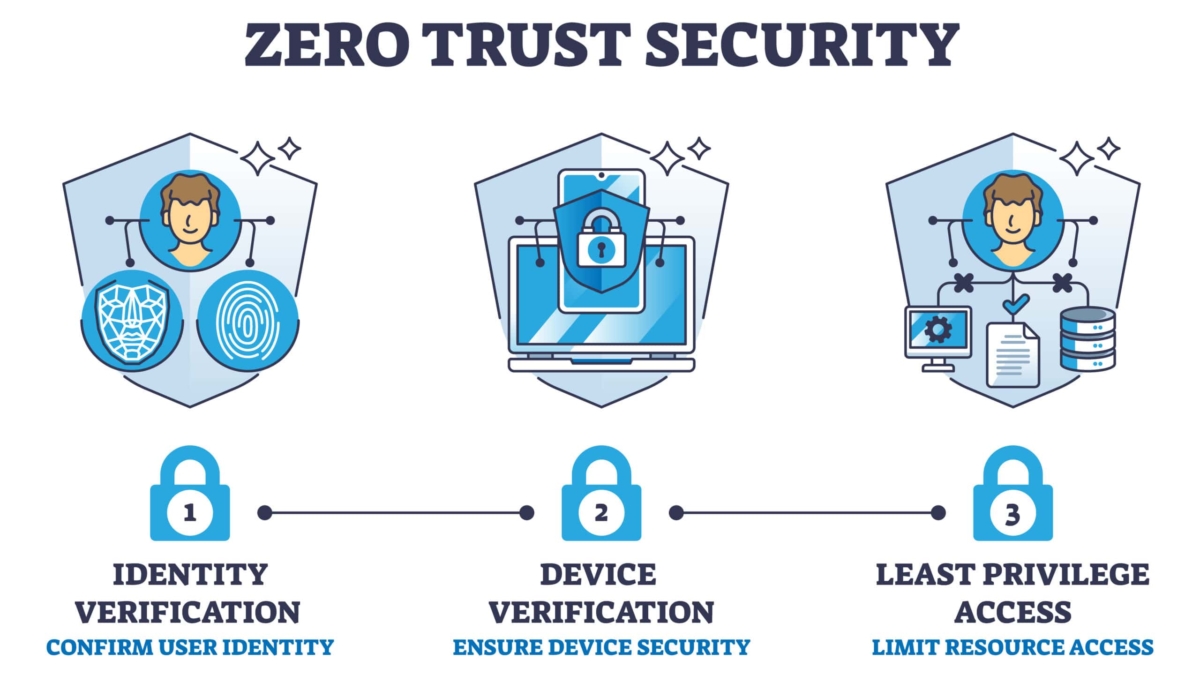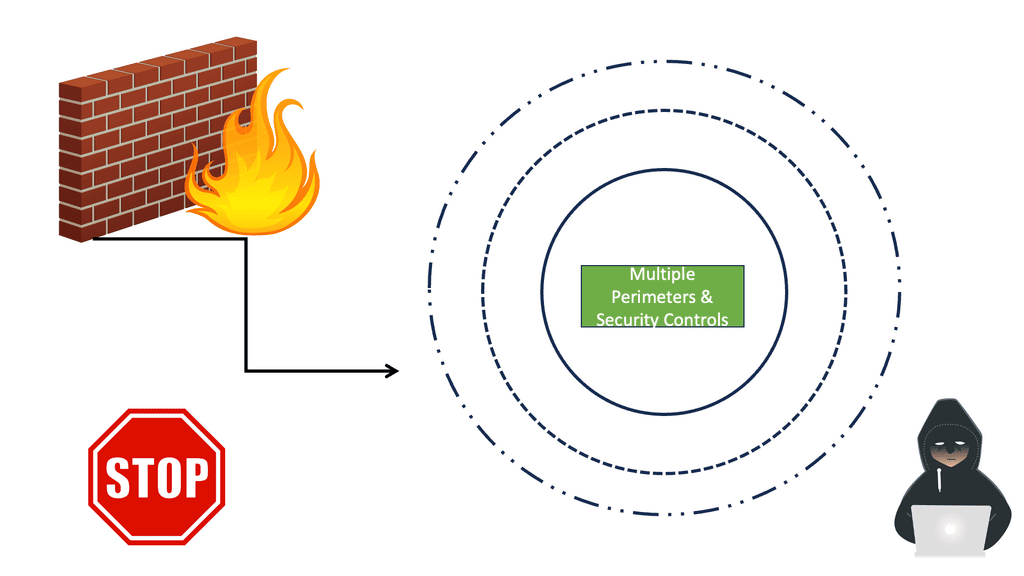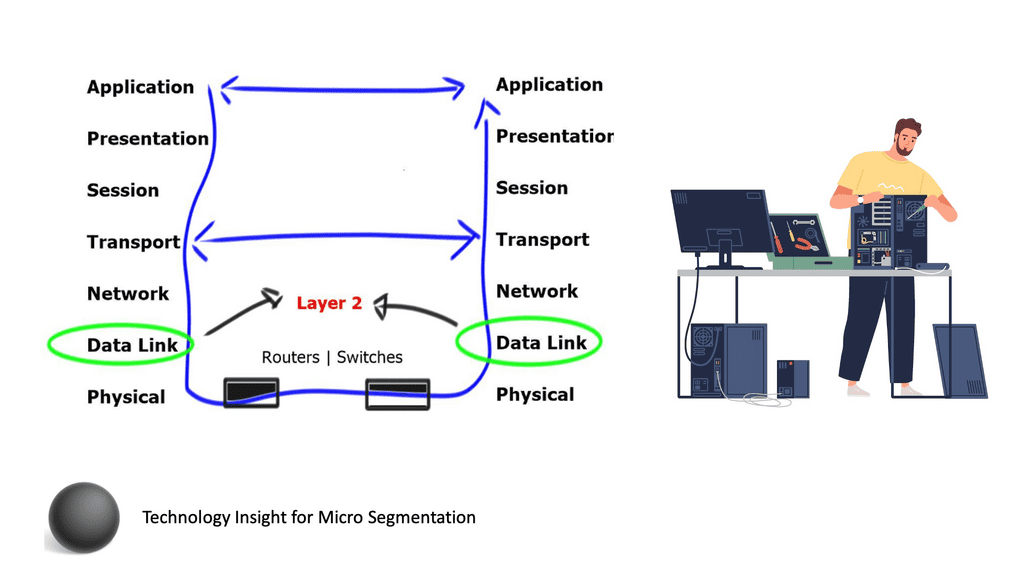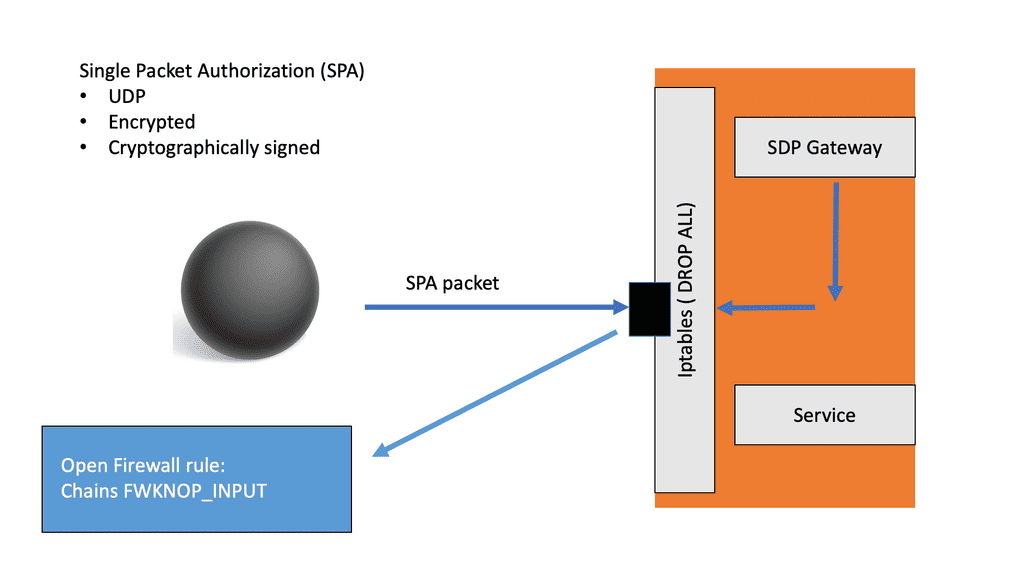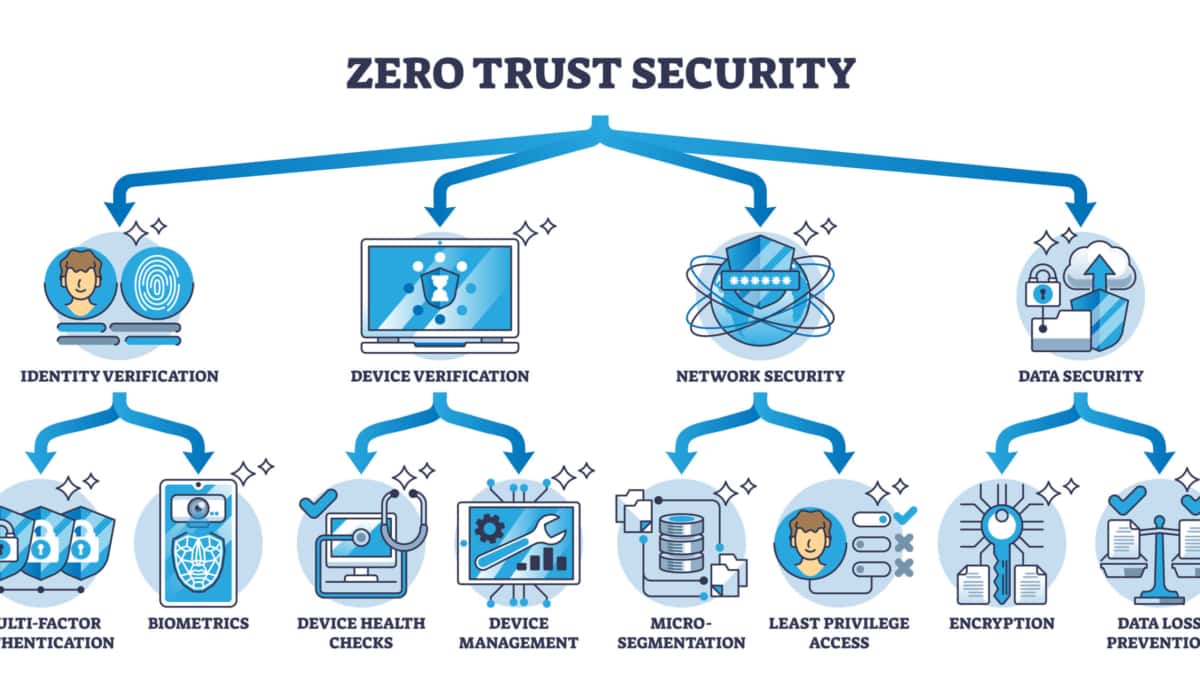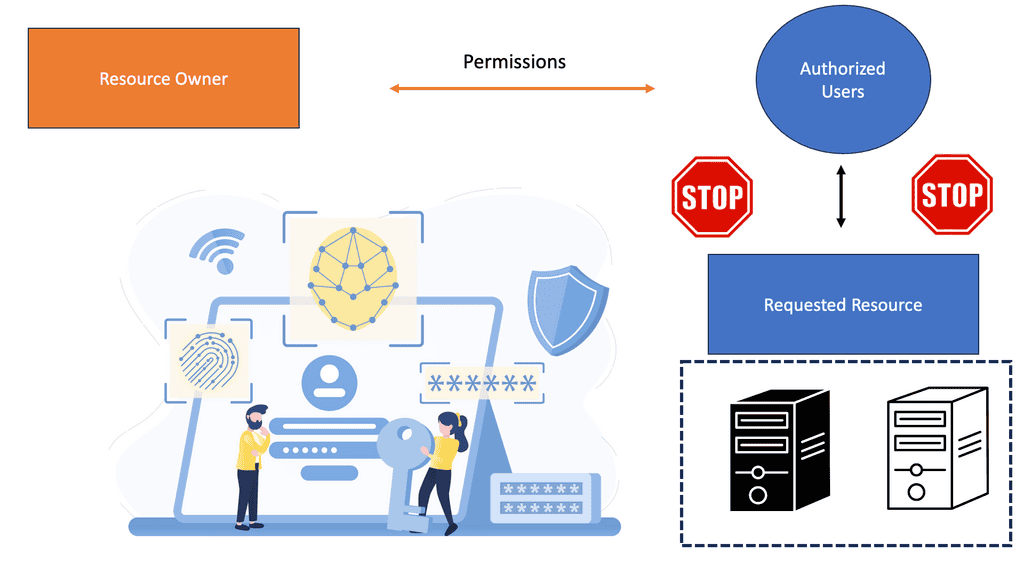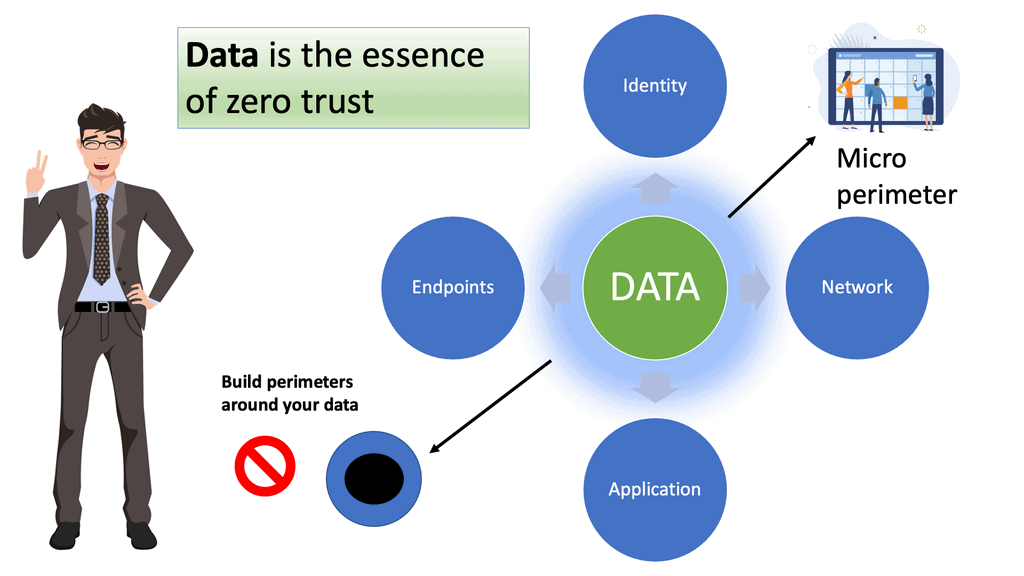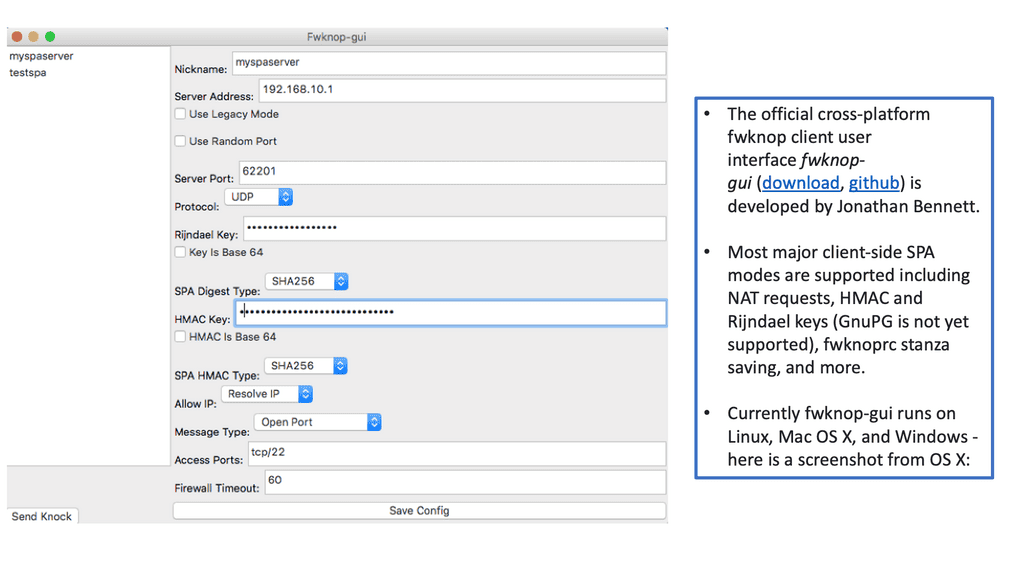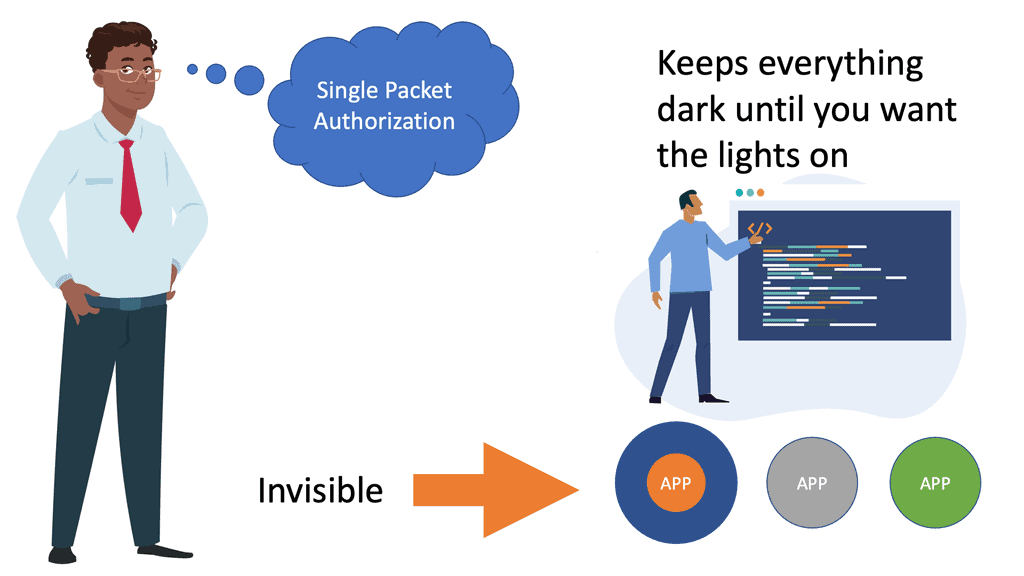Zero Trust Network Design
In today's interconnected world, where data breaches and cyber threats have become commonplace, traditional perimeter defenses are no longer enough to protect sensitive information. Enter Zero Trust Network Design is a security approach that prioritizes data protection by assuming that every user and device, inside or outside the network, is a potential threat. In this blog post, we will explore the Zero Trust Network Design concept, its principles, and its benefits in securing the modern digital landscape.
Zero trust network design is a security concept that focuses on reducing the attack surface of an organization’s network. It is based on the assumption that users and systems inside a network are untrusted, and therefore, all traffic is considered untrusted and must be verified before access is granted. This contrasts traditional networks, which often rely on perimeter-based security to protect against external threats.
Key Points:
-Identity and Access Management (IAM): IAM plays a vital role in Zero Trust by ensuring that only authenticated and authorized users gain access to specific resources. Multi-factor authentication (MFA) and strong password policies are integral to this component.
-Network Segmentation: Zero Trust advocates for segmenting the network into smaller, more manageable zones. This helps contain potential breaches and restricts lateral movement within the network.
-Continuous Monitoring and Analytics: Real-time monitoring and analysis of network traffic, user behavior, and system logs are essential for detecting any anomalies or potential security breaches.
-Enhanced Security: By adopting a Zero Trust approach, organizations significantly reduce the risk of unauthorized access and lateral movement within their networks, making it harder for cyber attackers to exploit vulnerabilities.
-Improved Compliance: Zero Trust aligns with various regulatory and compliance requirements, providing organizations with a structured framework to ensure data protection and privacy.
-Greater Flexibility: Zero Trust allows organizations to embrace modern workplace practices, such as remote work and BYOD (Bring Your Own Device), without compromising security. Users can securely access resources from anywhere, anytime.
Implementing Zero Trust requires a well-defined strategy and careful planning. Here are some key steps to consider:
1. Assess Current Security Infrastructure: Conduct a thorough assessment of existing security measures, identify vulnerabilities, and evaluate the readiness for Zero Trust implementation.
2. Define Trust Boundaries: Determine the trust boundaries within the network and establish access policies accordingly. Consider factors like user roles, device types, and resource sensitivity.
3. Choose the Right Technologies: Select security solutions and tools that align with your organization's needs and objectives. These may include next-generation firewalls, secure web gateways, and identity management systems.
Matt Conran
Highlights: Zero Trust Network Design
Never Trust, Always Verify
The core concept of zero-trust network design and segmentation is never to trust, always verify. This means that all traffic, regardless of its origin, must be verified before access is granted. This is achieved through layered security controls, including authentication, authorization, encryption, and monitoring.
Authentication is used to verify the identity of users and devices before allowing access to resources. Authorization is used to determine what resources a user or device is allowed to access. Encryption is used to protect data in transit and at rest. Monitoring is used to detect threats and suspicious activity.
Zero Trust Network Segmentation
Zero-trust network design, including zero-trust network segmentation, is becoming increasingly popular as organizations move away from perimeter-based security. By verifying all traffic rather than relying on perimeter-based security, organizations can reduce their attack surface and improve their overall security posture. Segmentation can work at different layers of the OSI Model.
With a zero-trust network segmentation approach, networks are segmented into smaller islands with specific workloads. In addition, each segment has its own ingress and egress controls to minimize the “blast radius” of unauthorized access to data.
Related: For pre-information, you may find the following helpful:
Zero Trust Architecture Key Zero Trust Network Design Discussion Points: |
|
Back to Basics: Zero Trust Network Design
Challenging Landscape
The drive for a zero trust networking and software defined perimeter is again gaining momentum. The bad actors are getting increasingly sophisticated, resulting in a pervasive sense of unease in traditional networking and security methods. So why are our network infrastructure and applications open to such severe security risks? This Zero Trust tutorial will recap some technological weaknesses driving the path to Zero Trust network design and Zero Trust SASE.
We give devices IP addresses to connect to the Internet and signposts three pathways. None of these techniques ensures attacks will not happen. They are like preventive medicine. However, with bad actor sophistication, we need to be more at a total immunization level to ensure that attacks cannot even touch your infrastructure by implementing a zero trust security strategy and software defined perimeter solutions.
Understanding Zero Trust Network Design:
Zero Trust Network Design is a security framework that aims to prevent and mitigate cyber-attacks by continuously verifying and validating every access request. Unlike the traditional perimeter-based security model, Zero Trust Network Design leverages several core principles to achieve a higher level of security:
1. Least Privilege: Users and devices are granted only the minimum level of access required to perform their specific tasks. This principle ensures that the potential damage is limited even if a user’s credentials are compromised.
2. Micro-Segmentation: Networks are divided into smaller, isolated segments, making it more challenging for an attacker to move laterally and gain unauthorized access to critical systems or data.
3. Continuous Authentication: Zero-trust network Design emphasizes multi-factor authentication and continuous verification of user identity and device health rather than relying solely on static credentials like usernames and passwords.
4. Network Visibility: Comprehensive monitoring and logging are crucial components of Zero Trust Network Design. Organizations can detect anomalies and potential security breaches in real-time by closely monitoring network traffic and inspecting all data packets.
Benefits of Zero Trust Network Design:
Implementing Zero Trust Network Design offers numerous benefits for organizations seeking to protect their sensitive data and mitigate cyber risks:
1. Enhanced Security: By assuming that all users and devices are untrusted, Zero Trust Network Design provides a higher security level against internal and external threats. It minimizes the risk of unauthorized access and helps organizations detect and respond to potential breaches more effectively.
2. Improved Compliance: Many industries have strict regulatory requirements for protecting sensitive data. Zero Trust Network Design addresses these compliance challenges by providing granular control over access permissions and ensuring that only authorized individuals can access critical information.
3. Reduced Attack Surface: Zero-trust network Design reduces potential attackers’ attack surface by segmenting networks and implementing strict access controls. This proactive approach makes it significantly harder for cybercriminals to move laterally within the network and gain access to sensitive data.
4. Simplified User Experience: Contrary to common misconceptions, implementing Zero Trust Network Design does not have to sacrifice user experience. With modern identity and access management solutions, users can enjoy a seamless and secure authentication process regardless of location or device.
Highlighting zero trust network segmentation
Zero-trust network segmentation is a process in which a network is divided into smaller, more secure parts. This can be done by using software firewalls, virtual LANs (VLANs), or other network security protocols. The purpose of zero-trust network segmentation, also known as microsegmentation, is to decrease a network’s attack surface and reduce the potential damage caused by a network breach. It also allows for more granular control over user access, which can help prevent unauthorized access to sensitive data.
Microsegmentation also allows for more efficient deployment of applications and more detailed monitoring and logging of network activity. By leveraging the advantages of microsegmentation, organizations can increase their network’s security and efficiency while protecting their data and resources.
Zero Trust: Changing the Approach to Security
Zero Trust is about fundamentally transforming the underlying philosophy and approach to enterprise security—shifting from outdated and demonstrably ineffective perimeter-centric methods to a dynamic, identity-centric, and policy-based system. Policies are at the heart of Zero Trust—after all, its primary architectural components are Policy Decision Points and Policy Enforcement Points. In our Zero Trust world, policies are the structures organizations create to define which identities are permitted access to resources under which circumstances.
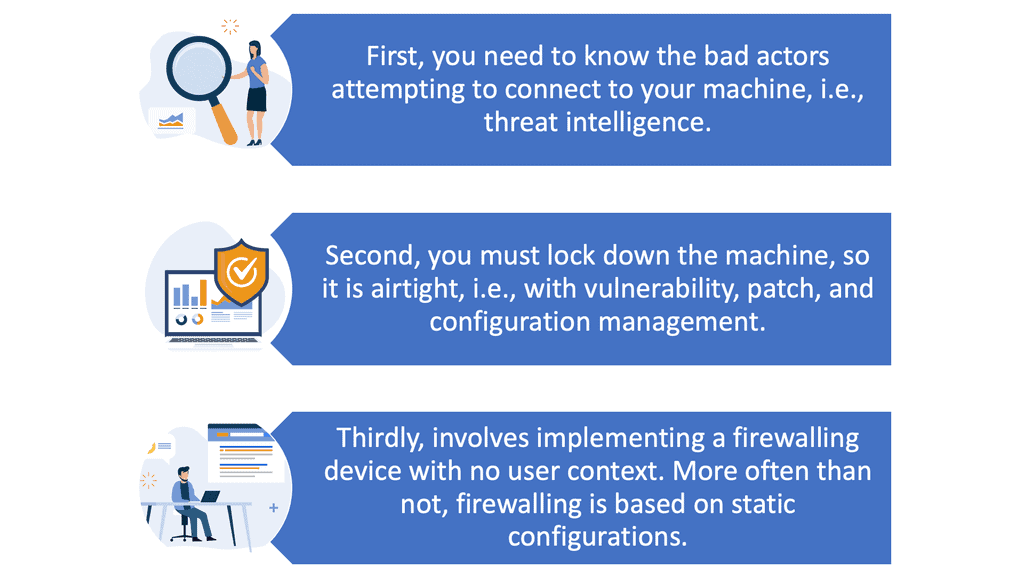
Introduction to Zero Trust Network Design
The idea behind the Zero Trust model and software-defined perimeter (SDP) is a connection-based security architecture designed to stop attacks. It doesn’t expose the infrastructure and its applications. Instead, it enables you to know the authorized users by authenticating, authorizing, and validating the devices they are on before connecting to protected resources.
A Zero-Trust architecture allows you to operate while vulnerabilities, patches, and configurations are in progress. Essentially, it cloaks applications or groups of applications so they are invisible to attack.
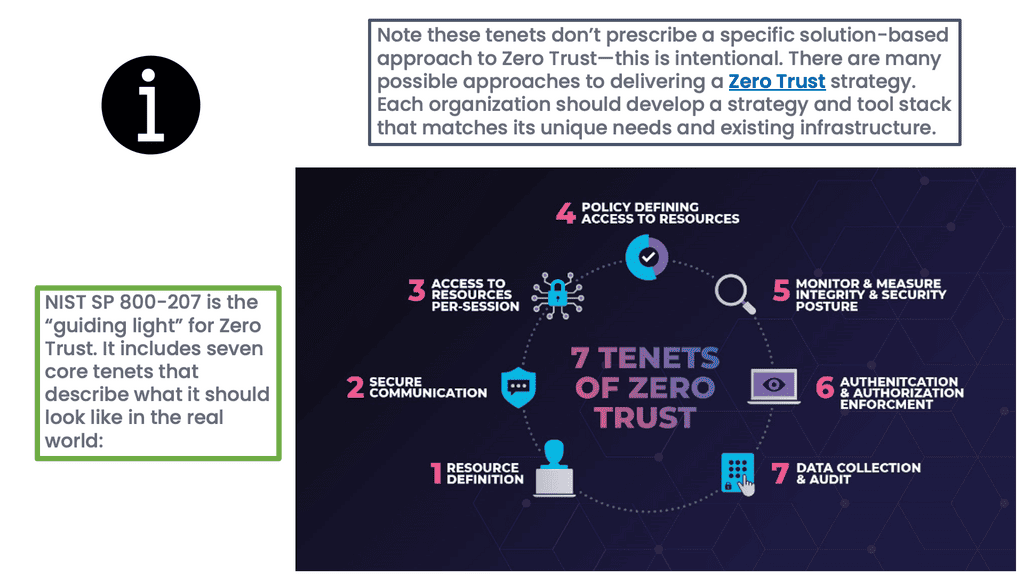
Zero Trust principles
Zero Trust Network ZTN and SDP are a security philosophy and set of Zero Trust principles, which, taken together, represent a significant shift in how security should be approached. Foundational security elements used before Zero Trust often achieved only coarse-grained separation of users, networks, and applications.
On the other hand, Zero Trust enhances this, effectively requiring that all identities and resources be segmented from one another. Zero Trust enables fine-grained, identity-and-context-sensitive access controls driven by an automated platform. Although Zero Trust started as a narrowly focused approach of not trusting any network identities until authenticated and authorized.
Traditional security boundaries
Traditionally, security boundaries were placed at the edge of the enterprise network in a classic “castle wall and moat” approach. However, a significant issue with this was the design and how we connected. Traditional non-zero Trust security solutions have been unable to bridge the disconnect between network and application-level security. Traditionally, users (and their devices) obtained broad access to networks, and applications relied upon authentication-only access control.
Issue 1 – We Connect First and Then Authenticate
Connect first, authenticate second.
TCP/IP is a fundamentally open network protocol that facilitates easy connectivity and reliable communications between distributed computing nodes. It has served us well in enabling our hyper-connected world but—for various reasons—doesn’t include security as part of its core capabilities.
TCP has a weak security foundation
Transmission Control Protocol (TCP) has been around for decades and has a weak security foundation. When it was created, security was out of scope. TCP can detect and retransmit error packets but leave them to their default; communication packets are not encrypted, which poses security risks. In addition, TCP operates with a Connect First, Authenticate, Second operation model, which is inherently insecure. It leaves the two connecting parties wide open for an attack. When clients want to communicate and access an application, they first set up a connection.
Then only once the connect stage has been carried out successfully can the authentication stage occur. And once the authentication stage has been carried out, we can only begin to pass the data.
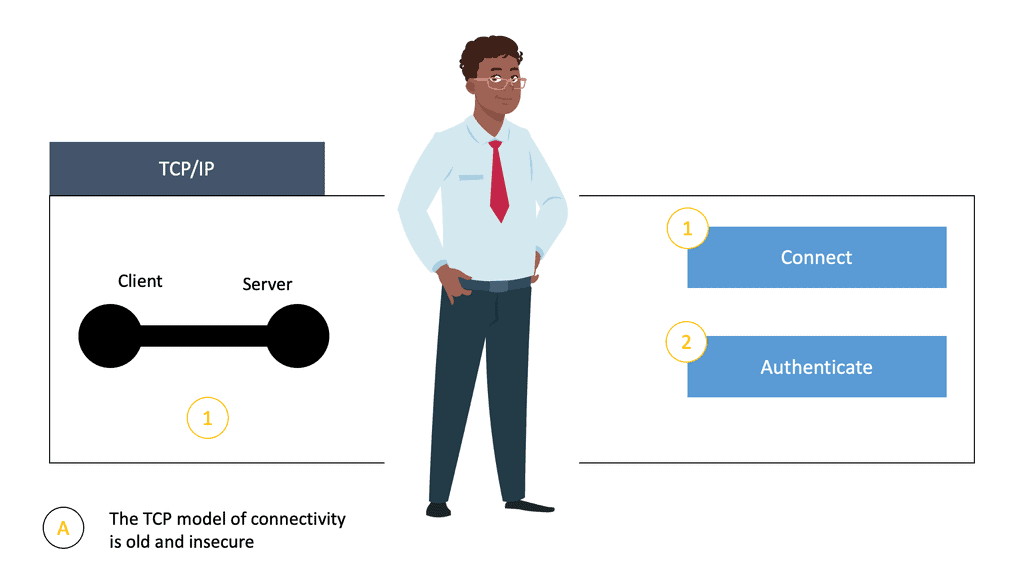
From a security perspective, the most important thing to understand is that this connection occurs purely at a network layer with no identity, authentication, or authorization. The beauty of this model is that it enables anyone with a browser to easily connect to any public web server without requiring any upfront registration or permission. This is a perfect approach for a public web server but a lousy approach for a private application.
The potential for malicious activity
With this process of Connect First and Authenticate Second, we are essentially opening up the door of the network and the application without knowing who is on the other side. Unfortunately, with this model, we have no idea who the client is until they have carried out the connect phase, and once they have connected, they are already in the network. Maybe the requesting client is not trustworthy and has bad intentions. If so, once they connect, they can carry out malicious activity and potentially perform data exfiltration.
Developing a Zero Trust Architecture
A zero-trust architecture requires endpoints to authenticate and be authorized before obtaining network access to protected servers. Then, real-time encrypted connections are created between requesting systems and application infrastructure. With a zero-trust architecture, we must establish trust between the client and the application before the client can set up the connection. Zero Trust is all about trust – never trust, always verify.
The trust is bi-directional between the client and the Zero Trust architecture ( that can take forms ) and the application to the Zero Trust architecture. It’s not a one-time check; it’s a continuous mode of operation. Once sufficient trust has been established, we move into the next stage, authentication. Once authentication has been set, we can connect the user to the application. Zero Trust access events flip the entire security model and make it more robust.
- We have gone from connecting first, authenticating second to authenticate first, connect second.
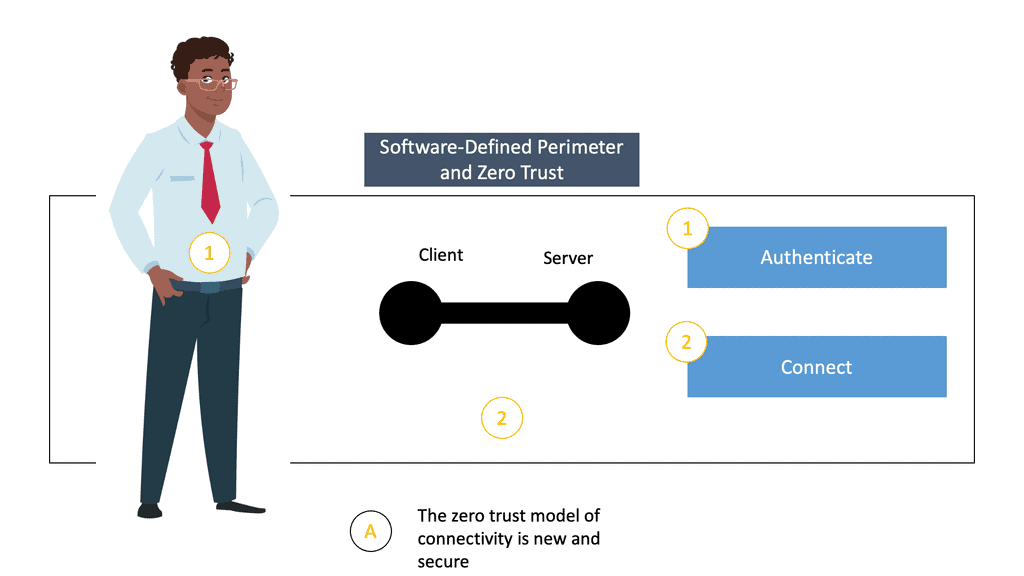
Example of a zero-trust network access
Single Pack Authorization ( SPA)
The user cannot see or know where the applications are located. SDP hides the application and creates a “dark” network by using Single Packet Authorization (SPA) for the authorization.
SPAs’ goal, also known as Single Packet Authentication, is to overcome the open and insecure nature of TCP/IP, which follows a “connect then authenticate” model. SPA is a lightweight security protocol that validates a device or user’s identity before permitting network access to the SDP. The purpose of SPA is to allow a service to be darkened via a default-deny firewall.
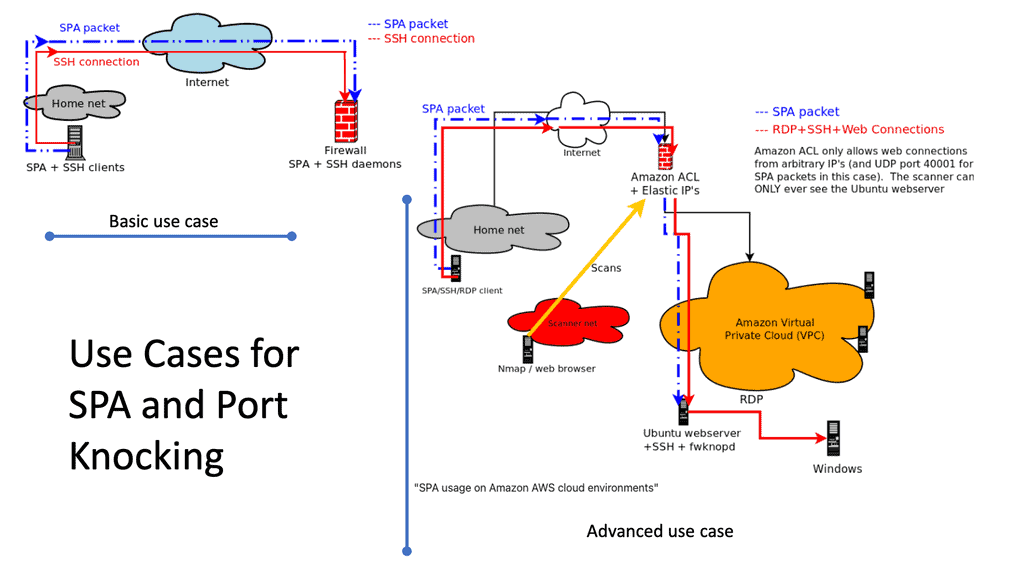
The systems use a One-Time-Password (OTP) generated by algorithm 14 and embed the current password in the initial network packet sent from the client to the Server. The SDP specification mentions using the SPA packet after establishing a TCP connection. In contrast, the open-source implementation from the creators of SPA15 uses a UDP packet before the TCP connection.
Issue 2 – Fixed perimeter approach to networking and security
Traditionally, security boundaries were placed at the edge of the enterprise network in a classic “castle wall and moat” approach. However, as technology evolved, remote workers and workloads became more common. As a result, security boundaries necessarily followed and expanded from just the corporate perimeter.
The traditional world of static domains
The traditional world of networking started with static domains. Networks were initially designed to create internal segments separated from the external world by a fixed perimeter. The classical network model divided clients and users into trusted and untrusted groups. The internal network was deemed trustworthy, whereas the external was considered hostile.
The perimeter approach to network and security has several zones. We have, for example, the Internet, DMZ, Trusted, and then Privileged. In addition, we have public and private address spaces that separate network access from here. Private addresses were deemed more secure than public ones as they were unreachable online. However, this trust assumption that all private addresses are safe is where our problems started.

The fixed perimeter
The digital threat landscape is concerning. We are getting hit by external threats to your applications and networks from all over the world. They also come internally within your network, and we have insider threats within a user group and internally as insider threats across user group boundaries. These types of threats need to be addressed one by one.
One issue with the fixed perimeter approach is that it assumes trusted internal and hostile external networks. However, we must assume that the internal network is as hostile as the external one.
Over 80% of threats are from internal malware or malicious employees. The fixed perimeter approach to networking and security is still the foundation for most network and security professionals, even though a lot has changed since the design’s inception.
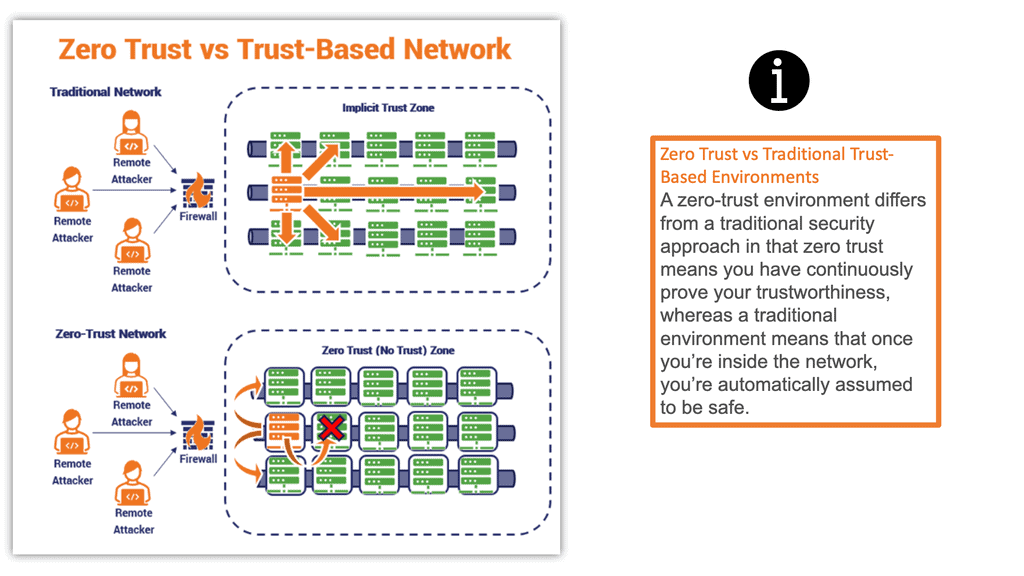
We get hacked daily!
We are now at a stage where 45% of US companies have experienced a data breach. The 2022 Thales Data Threat Report found that almost half (45%) of US companies suffered a data breach in the past year. However, this could be higher due to the potential for undetected breaches.
We are getting hacked daily, and major networks with skilled staff are crashing. Unfortunately, the perimeter approach to networking has failed to provide adequate security in today’s digital world. It works to an extent by delaying an attack. However, a bad actor will eventually penetrate your guarded walls with enough patience and skill.
If a large gate and walls guard your house, you would feel safe and think you are fully protected while inside the house. However, the perimeter protecting your home may be as large and thick as possible. There is still a chance that someone can climb the walls, access your front door, and enter your property. However, if a bad actor cannot even see your house, they cannot take the next step and try to breach your security.
Issue 3 – Dissolved perimeter caused by the changing environment
The environment has changed with the introduction of the cloud, advanced BYOD, machine-to-machine connections, the rise in remote access, and phishing attacks. We have many internal devices and a variety of users, such as on-site contractors that need to access network resources.
There is also a trend for corporate devices to move to the cloud, collocated facilities, and off-site to customer and partner locations. In addition, it is becoming more diversified with hybrid architectures.

These changes are causing major security problems with the fixed perimeter approach to networking and security. For example, with the cloud, the internal perimeter is stretched to the cloud, but traditional security mechanisms are still being used. But it is an entirely new paradigm. Also, some abundant remote workers work from various devices and places.
Again, traditional security mechanisms are still being used. As our environment evolves, security tools and architectures must evolve. Let’s face it: the network perimeter has dissolved as your remote users, things, services, applications, and data are everywhere. In addition, as the world moves to the cloud, mobile, and the IoT, the ability to control and secure everything in the network is no longer available.
Phishing attacks are on the rise.
We have witnessed increased phishing attacks that can result in a bad actor landing on your local area network (LAN). Phishing is a type of social engineering where an attacker sends a fraudulent message designed to trick a person into revealing sensitive information to the attacker or to deploy malicious software on the victim’s infrastructure, like ransomware. The term “phishing” was first used in 1994 when a group of teens worked to obtain credit card numbers from unsuspecting users on AOL manually.
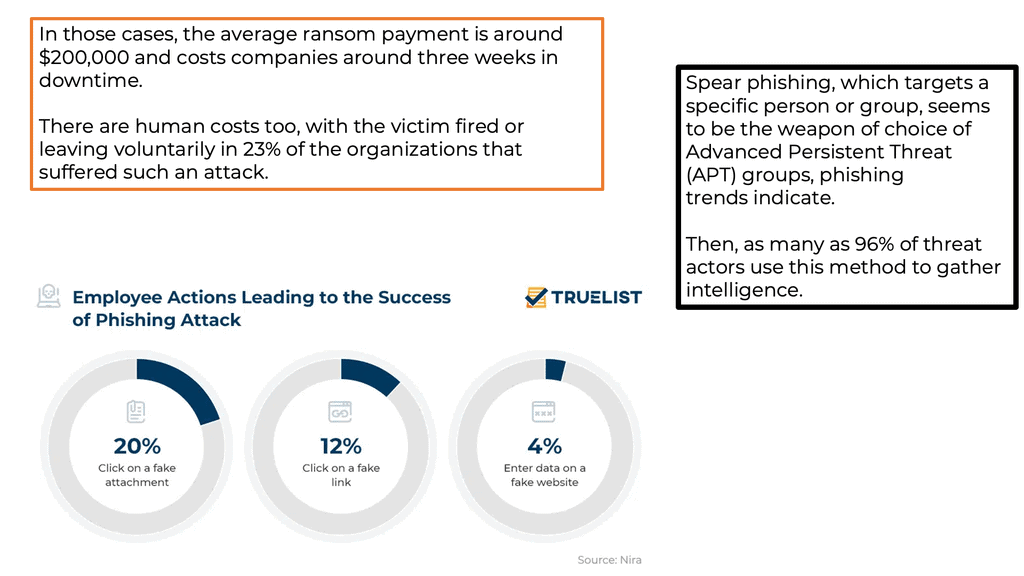
Hackers are inventing new ways.
By 1995, they had created a program called AOHell to automate their work. Since then, hackers have continued to invent new ways to gather details from anyone connected to the internet. These actors have created several programs and types of malicious software that are still used today.
Recently, I was a victim of a phishing email. Clicking and downloading the file is very easy if you are not educated about phishing attacks. In my case, the particular file was a .wav file. It looked safe, but it was not.
Issue 4 – Broad-level access
So, you may have heard of broad-level access and lateral movements. Remember, with traditional network and security mechanisms, when a bad actor lands on a particular segment, i.e., a VLAN, known as zone-based networking, they can see everything on that segment. So this gives them broad-level access. But, generally speaking, when you are on a VLAN, you can see everything in that VLAN, and VLAN-to-VLAN communication is not the hardest thing to do, resulting in lateral movements.
The issue of lateral movements
Lateral movement is the technique attackers use to progress through the organizational network after gaining initial access. Adversaries use lateral movement to identify target assets and sensitive data for their attack. Lateral movement is the tenth step in the MITRE Att&ck framework. It is the set of techniques attackers use to move in the network while gaining access to credentials without being detected.
No intra-VLAN filtering
This is made possible as, traditionally, a security device does not filter this low down on the network, i.e., inside of the VLAN, known as intra-VLAN filtering. A phishing email can easily lead the bad actor to the LAN with broad-level access and the capability to move laterally throughout the network.
For example, a bad actor can initially access an unpatched central file-sharing server; they move laterally between segments to the web developers’ machines and use a keylogger to get the credentials to access critical information on the all-important database servers.
They can then carry out data exfiltration with DNS or even a social media account like Twitter. However, firewalls generally do not check DNS as a file transfer mechanism, so data exfiltration using DNS will often go unnoticed.
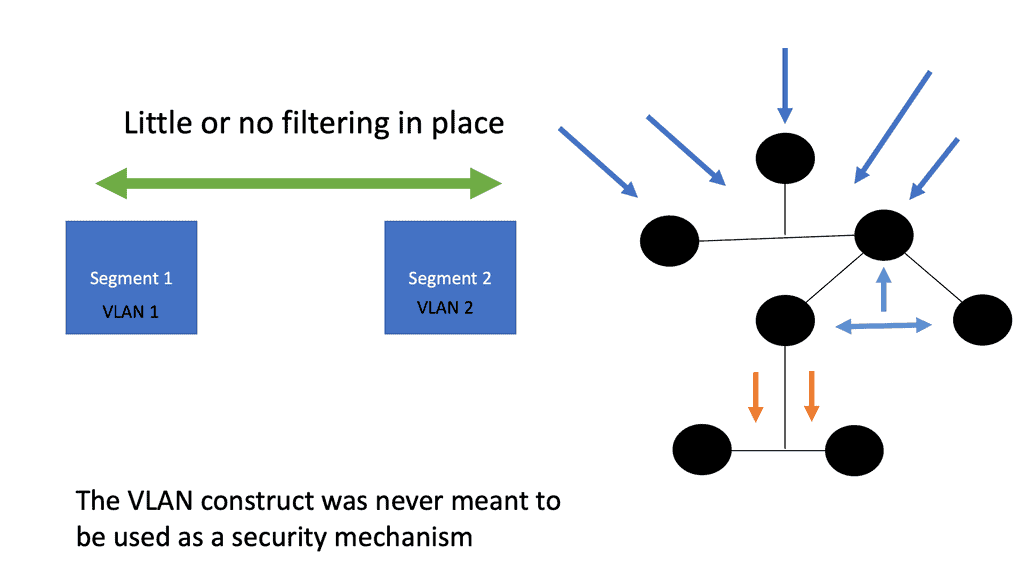
Issue 5 – The challenges with traditional firewalls
The limited world of 5-tuple
Traditional firewalls typically control access to network resources based on source IP addresses. This creates the fundamental challenge of securing admission. Namely, we need to solve the user access problem, but we only have the tools to control access based on IP addresses.
As a result, you have to group users, some of whom may work in different departments and roles, to access the same service and with the same IP addresses. The firewall rules are also static and don’t change dynamically based on levels of trust on a given device. They provide only network information.
Maybe the user moves to a more risky location, such as an Internet cafe, its local Firewall, or antivirus software that has been turned off by malware or even by accident. Unfortunately, a traditional firewall cannot detect this and live in the little world of the 5-tuple. Traditional firewalls can only express static rule sets and not communicate or enforce rules based on identity information.
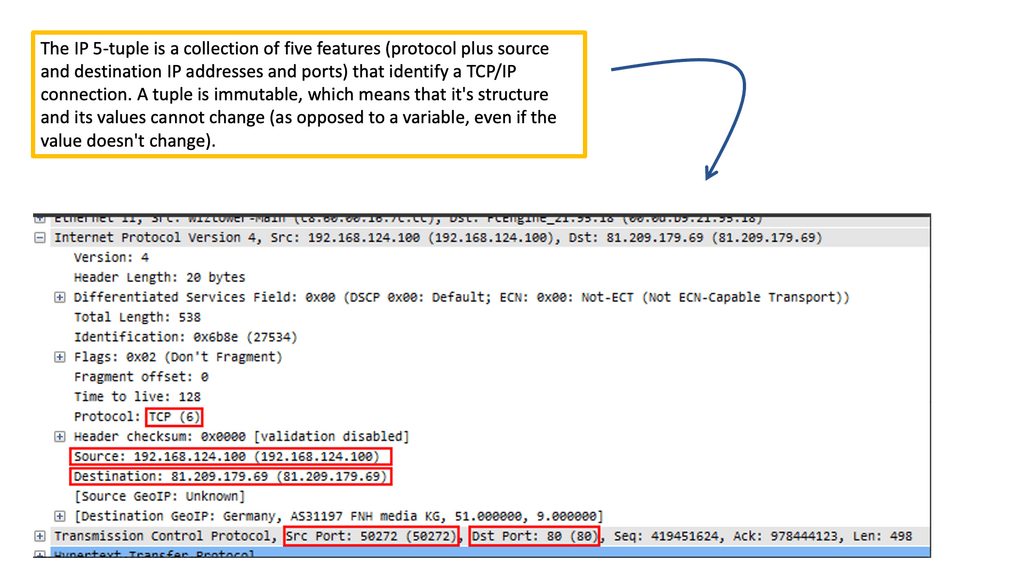
Issue 6 – A Cloud-focused environment
Upon examining the cloud, let’s compare a public parking space. A public cloud is where you can put your car compared to your vehicle in your parking garage. In a public parking space, we have multiple tenants who can take your area, but we don’t know what they can do to your car.
Today, we are very cloud-focused, but when moving applications to the cloud, we need to be very security-focused. However, the cloud environment is less mature in providing the traditional security control we use in our legacy environment.
So, when putting applications in the cloud, you shouldn’t leave security to its default. Why?? Firstly, we operate in a shared model where the tenant after you can steal your encryption keys or data. There have been a lot of cloud breaches. We have firewalls with static rulesets, authentication, and key management issues in cloud protection.
Control point change
One of the biggest problems is that the perimeter has moved when you move to a cloud-based application. Servers are no longer under your control. Mobile and tablets exacerbate the problem as they can be located everywhere. So, trying to control the perimeter is very difficult. More importantly, firewalls only have access to and control network information and should have more content.
Defining this perimeter is what ZTNA architecture and software-defined perimeter are doing. Cloud users now manage firewalls by moving their applications to the cloud, not the I.T. teams within the cloud providers.
So when moving applications to the cloud, even though cloud providers provide security tools, the cloud consumer has to integrate security to have more visibility than they have today.
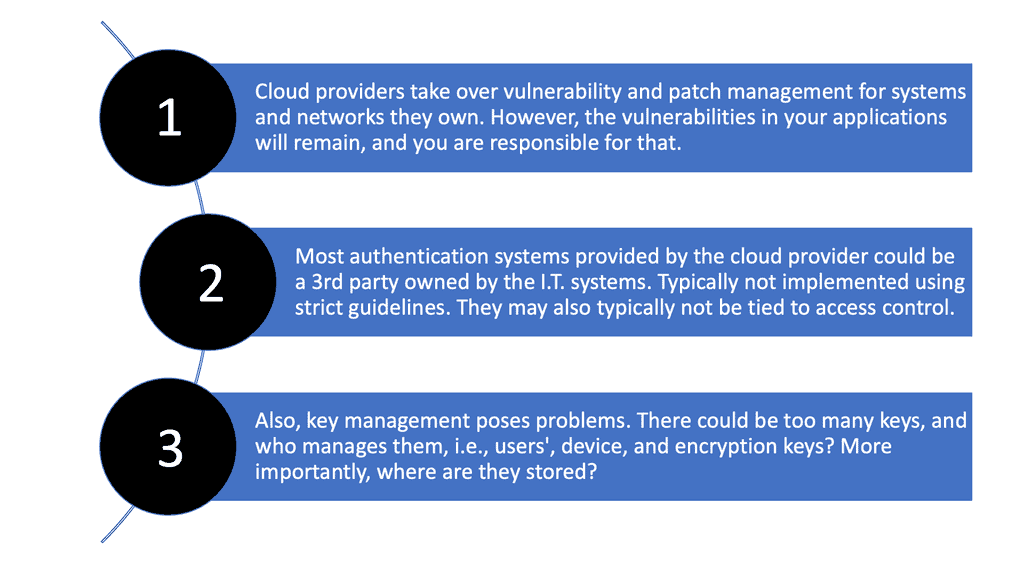
Before, we had clear network demarcation points set by a central physical firewall creating inside and outside trust zones. Anything outside was considered hostile, and anything on the inside was deemed trusted.
1. Connection-centric model
The Zero Trust model flips this around and considers everything untrusted. To do this, there are no longer pre-defined fixed network demarcation points. Instead, the network perimeter initially set in stone is now fluid and software-based.
Zero Trust is connection-centric, not network-centric. Each user on a specific device connected to the network gets an individualized connection to a particular service hidden by the perimeter.
Instead of having one perimeter every user uses, SDP creates many small perimeters purposely built for users and applications. These are known as micro perimeters. Clients are cryptographically signed into these microperimeters.
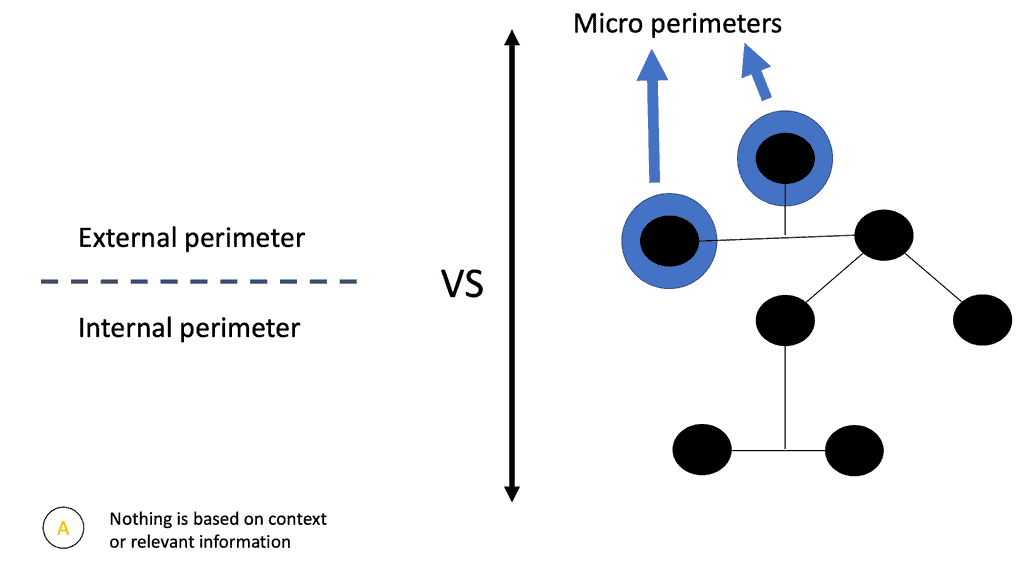
2. Micro perimeters: Zero trust network segmentation
The micro perimeter is based on user and device context and can dynamically adjust to environmental changes. So, as a user moves to different locations or devices, the Zero Trust architecture can detect this and set the appropriate security controls based on the new context.
The data center is no longer the center of the universe. Instead, the user on specific devices, along with their service requests, is the new center of the universe.
Zero Trust does this by decoupling the user and device from the network. The data plane is separated from the network to remove the user from the control plane. The control plane is where the authentication happens first.
Then, the data plane, the client-to-application connection, transfers the data. Therefore, the users don’t need to be on the network to gain application access. As a result, they have the least privilege and no broad-level access.
Concept: Zero trust network segmentation
Zero-trust network segmentation is gaining traction in cybersecurity due to its ability to provide increased protection to an organization’s network. This method of securing networks is based on the concept of “never trust, always verify,” meaning that all traffic must be authenticated and authorized before it can access the network.
This is accomplished by segmenting the network into multiple isolated zones accessible only through specific access points, which are carefully monitored and controlled.
Network segmentation is a critical component of a zero-trust network design. By dividing the network into smaller, isolated units, it is easier to monitor and control access to the network. Additionally, segmentation makes it harder for attackers to move laterally across the network, reducing the chance of a successful attack.
Zero-trust network design segmentation is essential to any organization’s cybersecurity strategy. By utilizing segmentation, authentication, and monitoring systems, organizations can ensure their networks are secure and their data is protected.
A final issue 7 – The I.P. address conundrum
Everything today relies on I.P. addresses for trust, but there is a problem: I.P. addresses lack user knowledge to assign and validate the device’s trust. There is no way for an I.P. address to do this. I.P. addresses provide connectivity but do not get involved in validating the trust of the endpoint or the user.
Also, I.P. addresses should not be used as an anchor for network locations as they are today because when a user moves from one place to another, the I.P. address changes.
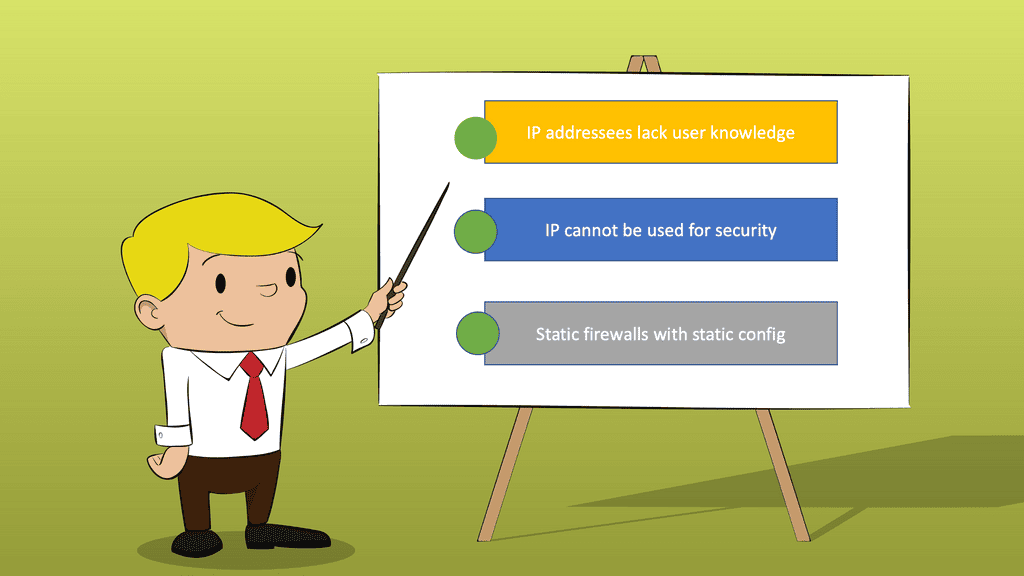
Can’t have security related to an I.P. address.
But what about the security policy assigned to the old IP addresses? What happens with your change I.P.s? Anything tied to I.P. is ridiculous, as we don’t have a good hook to hang things on for security policy enforcement. There are several facets to policy. For example, the user access policy touches on authorization, the network access policy touches on what to connect to, and user account policies touch on authentication.
With either one, there is no policy visibility with I.P. addresses. This is also a significant problem for traditional firewalling, which displays static configurations; for example, a stationary design may state that this particular source can reach this destination using this port number.
Security-related issues to I.P.
- This has no meaning. There is no indication of why that rule exists and under what conditions a packet should be allowed from one source to another.
- No contextual information is taken into consideration. When creating a robust security posture, we must consider more than ports and IP addresses.
For a robust security posture, you need complete visibility into the network to see who, what, when, and how they connect with the device. Unfortunately, today’s Firewall is static and only contains information about the network.
On the other hand, Zero Trust enables a dynamic firewall with the user and device context to open a firewall for a single secure connection. The Firewall remains closed at all other times, creating a ‘black cloud’ stance regardless of whether the connections are made to the cloud or on-premise.
The rise of the next-generation firewall?
Next-generation firewalls are more advanced than traditional firewalls. They use the information in layers 5 through 7 (session layer, presentation layer, and application layer) to perform additional functions. They can provide advanced features such as intrusion detection, prevention, and virtual private networks.
Today, most enterprise firewalls are “next generation” and typically include IDS/IPS, traffic analysis and malware detection for threat detection, URL filtering, and some degree of application awareness/control.
Like the NAC market segment, vendors in this area began a journey to identity-centric security around the same time Zero Trust ideas began percolating through the industry. Today, many NGFW vendors offer Zero Trust capabilities, but many operate with the perimeter security model.
Still, IP-based security systems
NGFWs are still IP-based systems offering limited identity and application-centric capabilities. In addition, they are static firewalls. Most do not employ zero-trust segmentation, and they often mandate traditional perimeter-centric network architectures with site-to-site connections and don’t offer flexible network segmentation capabilities. Similar to conventional firewalls, their access policy models are typically coarse-grained, providing users with broader network access than what is strictly necessary.
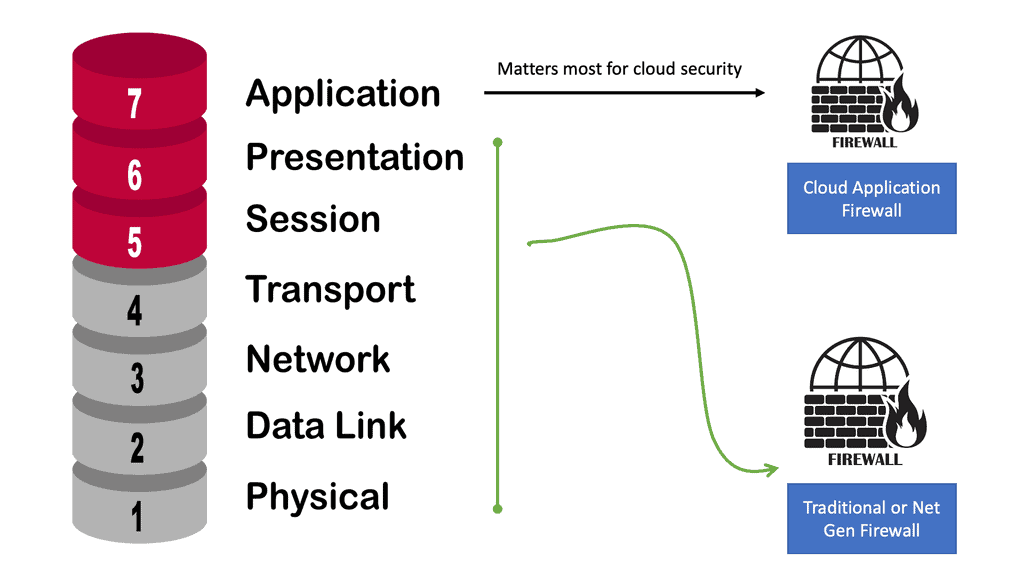
Conclusion:
Zero Trust Network Design represents a paradigm shift in network security, recognizing that traditional perimeter defenses are no longer sufficient to protect against the evolving threat landscape. By implementing this approach, organizations can significantly enhance their security posture, minimize the risk of data breaches, and ensure compliance with regulatory requirements. As the digital landscape evolves, Zero Trust Network Design offers a robust framework for safeguarding sensitive information in an increasingly interconnected world.
Summary: Zero Trust Network Design
Traditional network security measures are no longer sufficient in today’s digital landscape, where cyber threats are becoming increasingly sophisticated. Enter zero trust network design, a revolutionary approach that challenges the traditional perimeter-based security model. In this blog post, we will delve into the concept of zero-trust network design, its key principles, benefits, and implementation strategies.
Understanding Zero Trust Network Design
Zero-trust network design is a security framework that operates on the principle of “never trust, always verify.” Unlike traditional perimeter-based security, which assumes trust within the network, zero-trust treats every user, device, or application as potentially malicious. This approach is based on the belief that trust should not be automatically granted but continuously verified, regardless of location or network access method.
Key Principles of Zero Trust
Certain key principles must be followed to implement zero trust network design effectively. These principles include:
1. Least Privilege: Users and devices are granted the minimum level of access required to perform their tasks, reducing the risk of unauthorized access or lateral movement within the network.
2. Microsegmentation: The network is divided into smaller segments or zones, allowing granular control over network traffic and limiting the impact of potential breaches or lateral movement.
3. Continuous Authentication: Authentication and authorization are not just one-time events but are verified throughout a user’s session, preventing unauthorized access even after initial login.
Benefits of Zero Trust Network Design
Implementing a zero-trust network design offers several significant benefits for organizations:
1. Enhanced Security: By adopting a zero-trust approach, organizations can significantly reduce the attack surface and mitigate the risk of data breaches or unauthorized access.
2. Improved Compliance: Zero trust network design aligns with many regulatory requirements, helping organizations meet compliance standards more effectively.
3. Greater Flexibility: Zero trust allows organizations to embrace modern workplace trends, such as remote work and cloud-based applications, without compromising security.
Implementing Zero Trust
Implementing a trust network design requires careful planning and a structured approach. Some key steps to consider are:
1. Network Assessment: Conduct a thorough assessment of the existing network infrastructure, identifying potential vulnerabilities or areas that require improvement.
2. Policy Development: Define comprehensive security policies that align with zero trust principles, including access control, authentication mechanisms, and user/device monitoring.
3. Technology Adoption: Implement appropriate technologies and tools that support zero-trust network design, such as network segmentation solutions, multifactor authentication, and continuous monitoring systems.
Conclusion:
Zero trust network design represents a paradigm shift in network security, challenging traditional notions of trust and adopting a more proactive and layered approach. By implementing the fundamental principles of zero trust, organizations can significantly enhance their security posture, reduce the risk of data breaches, and adapt to evolving threat landscapes. Embracing the principles of least privilege, microsegmentation, and continuous authentication, organizations can revolutionize their network security and stay one step ahead of cyber threats.

